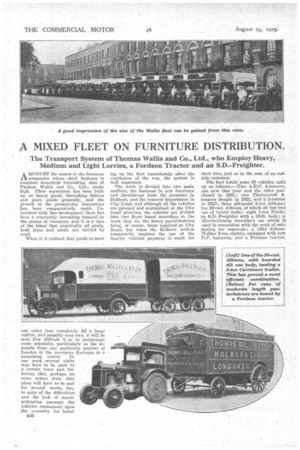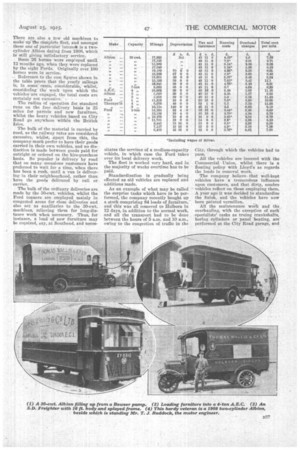A MIXED FLEET ON FURNITURE DISTRIBUTION.
Page 18

Page 19

Page 20

If you've noticed an error in this article please click here to report it so we can fix it.
The Transport System of Thomas Wallis and Co., Ltd., who Employ Heavy, Medium and Light Lorries, a Fordson Tractor and an S.D.-Freighter.
A MONGST the names of the foremost .A.coinpanies whose chief business is complete household furnishing, that of Thomas Wallis and Co., Ltd., ranks high. Their reputation has been built up on heavy goods, furnishing fabrics and piece goods generally, and the growth to the present-day dimensions has been comparatively rapid. Coincident with this development there has been a constantly increasing demand on the means of transport, and it is a sign of the times that practically all goods, both larg,c and small, are carried by road.
When it is realized that goods to meet one order may completely fill a large vehicle, and possibly even two, it will be seen how difficult it 4s to 'prearrange route schedule's, particularly as the demands from any particular quarter of London Or the provinces fluctuate to a Surprising extent. In
one week several visits may have to be paid to a certain town and, following this, perhaps •no more orders from that place will have to be met for several weeks, but, in spite of the difficulties and the lack of standardization amongst the vehicles consequent upon the necessity far build
E36' lug up the fleet immediately after the conclusion of the war, the system is well organized.
The work is divided into two main sections, the business in new furniture mid furnishings from the premises in Holborn, and the removal department in City Etoad, and although all the vehicles are garaged and maintained at the City Road premises, the vehicles are divided into two fleets based according to the , work they do, the heavy pantechnicons being, of course, those required at City Road, but when the Holborn sectian temporarily requires the use of the heavier vehicles payment is made for their hire, just as in the cake of an outside customer.
The fleet totals some 33 vehicles, split up as follows t—To A.E.C. 4-tonners, one new this year and the other purchased in 1921; two Thornycroft 4tonners bought in 1921, and a 2-tonner in 1923; three old-model 9-ton Albions; ten 30-cwt. Albions, of which all but two are of recent make; eight 1-ton Fords ; an S.D. Freighter with a 16-ft. body ; a Morris-Cowley traveller's car which is used in connection with the work of estimating for removals; a 1914 EdisonWalker 2-1on electric, equipped with new D.P. batteries, and a Fordson tractor: There are also a few old machines to make up the complete fleet, and amongst these one of particular intere* is a twocylinder Albion dating from 1908, which isstill giving Satisfactory service.
Some 26 horses were emp!oyed until, 12 months ago, when they were replaced by the eight Fords. Originally over 100 horses were in service. . Reference to the cost figures shown in the table prove that the yearly mileage is, in some cases, considerable, whilst, considering the work Upon which the vehicles are engaged, the total Costs are certainly not excessive: The radius of operation for standard runs on the free delivery basis is 25 miles for parcels and new furniture, whilst the heavy vehicles based on City Road go anywhere within the British Isles. .
The bulk of the material is carried by road, as the railway rates are considered excessive, whilst, apart from this, the company much prefer to have their goods
• carried in their own vehicles, and no distinction is made between goods paid for outright or ordered on the hire-purchase basis. So popular is delivery by road that on many occasions customers have preferred to wait for a time, when there has been a rush, until a van is delivering in their neighbourhood, rather than have the goods delivered by rail or carrier.
The bulk of the ordinary deliveries are made by the 30-cwt. vehicles, whilst the Ford tonners are employed mainly in congested areas for close deliveries and also act as auxiliaries to the 30-ewt. machines, relieving them for long-distance work when necessary. Thus, for instance, a load of new furniture may be required, say, at Southend, and neces
sitates the services of a medium-capacity vehicle, in which case the Ford takes over its local delivery work.
The fleet is worked very hard, and in the majority of weeks overtime has to be paid.
Standardization is gradually being effected as old vehicles are replaced and additions made.
A.s an example of what may be called the surprise tasks which have to be performed, the company recently bought up a stock comprising 84 loads of furniture, and this was all removed to Holborn in 12 days, in addition to the normal work, and all the transport had to be done between the hours of 5 a.m. and 10 a.m., owing to the congestion of traffic in the City, through which the vehicles had to Pass.
All the vehicles are insured with the Commercial Union, whilst there is a floating policy with Lloyd's as regards the loads in remeval work.
The company believe that well-kept vehicles have a tremendous influence upon customers, and that dirty, sombre vehicles reflect on those employing them. A year ago it was decided to standardize the finish, and the vehicles have now been painted vermilion.
All the maintenance wail and the overhauling, with the exception of such specialists' tasks as truing crankshafts, boring cylinders or panel beating, are performed at the City Road garage, and
here the vehicles are completely stripped and rebuilt.
One of the latest types of vehicle to be put into service is the S.D.-Freighter. This will carry loads of 2 tons and has a body of r,pmarkably large capacity, rolling of which is prevented by splaying the frame and utilizing a wider back axle.
To assist in carrying furniture of large bulk but comparatively light weight use is made of two 15-cwt. Carrimore trailers, which are employed with the 30cwt. Albions and give splendid service, making runs to Nottingham, etc., with new furniture, The S.D.-Freighter has run to Southend and does approximately 15 m.p.g. It is employed for conveying new furniture and has also proved particularly useful, owing to its low load-line, for transporting pianos.
The Fordson is engaged in hauling pantechnicons where the distances are not excessive, and it is of interest to note that, by the installation of a 10-ton lift in their City Road premises, the pantechnicons gen be conveyed bodily to any floor for loading or unloading.
Big developments will take place in the near future with regard to the extension of the Holborn premises, and there is no doubt that the fleet of motor vehicles will develop accordingly. We are indebted to Mr. A. C. Barnard, the transport manager, for his assistance in the preparation of this article.




























